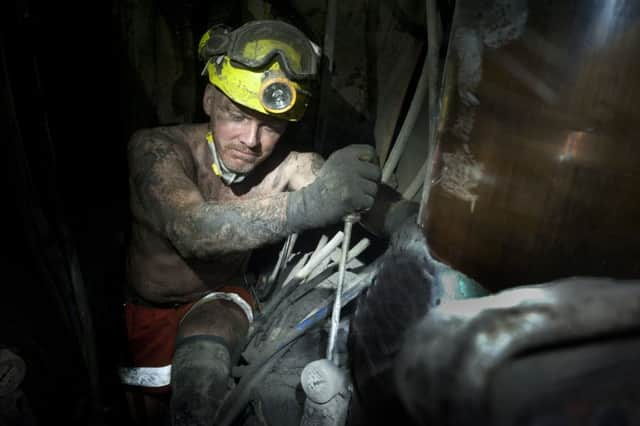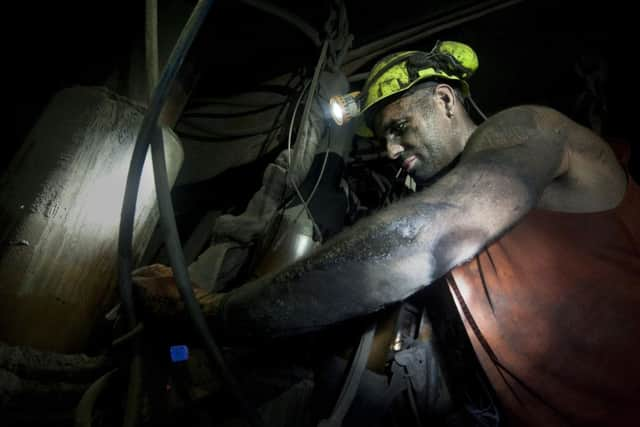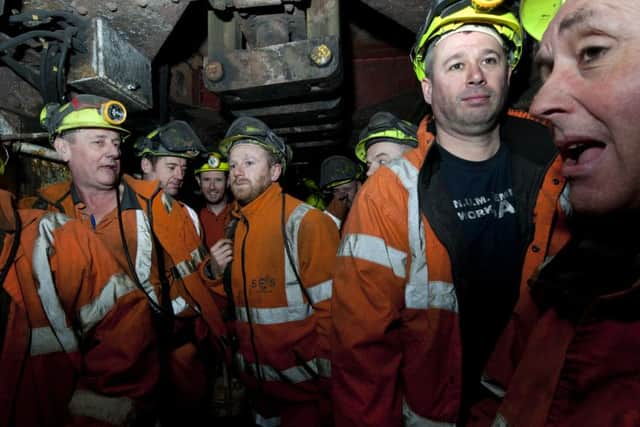New light on the day darkness fell on Kellingley


“I’d only been at Kellingley a couple of weeks, but I felt a real bond, a real affinity with the lads there and when of them later said: ‘C’mon, Roger, you’re one of us’, it was honestly the nicest thing anyone has ever said to me. Ever.”
It was an appropriately emotional end to an assignment which Roger describes as the most rewarding of his 36-year career behind the lens and which has resulted in the publication of a coffee table photographic book, The Last Days of Big K. It is an intimate portrait of those final days which marked not just the end of the Yorkshire colliery, but of Britain’s once proud deep-mining industry, which had never truly recovered since it was brought to its knees in the bitter strike of 1984/5.
Advertisement
Hide AdAdvertisement
Hide Ad“A lot of pits had closed before, but there was always somewhere else to move on to. There was always hope of another job underground. When Kellingley went, it wasn’t just the jobs that were lost, it was the hope that went too,” says Roger.


When a film crew arrived to make a two-part documentary for the BBC on the end of Kellingley they happened to mention they needed a stills photographer and a few of the South Wales miners who had moved north to work at the pit recommended Roger.
“I guess I have a reputation for taking pictures in the mines,” he says. “While my dad went into the Army I had uncles who worked down the pits and they got me access when I was just starting out as a photographer and it’s been a running theme throughout my career.
“When I got asked to go to Kellingley I really didn’t know what to expect. I was going up there to photograph a group of guys who were about to lose their jobs, but they couldn’t have made me more welcome. I wanted to capture what it was really like in the dying days of an industry and maybe it was because they could hide behind the coal dust on their faces, but they allowed me to photograph them up close, which I hope shows the level of trust which existed between us.
Advertisement
Hide AdAdvertisement
Hide Ad“It was interesting because I think it was only in the last couple of days that they really began to open up and show their true feelings. That’s when it sank in that come the next week they wouldn’t be pulling on their overalls and hard hats. Almost instantly the atmosphere changed and it was very difficult taking pictures because the emotions were so very raw.”


Kellingley was the last of more than 50 mines in Yorkshire to close and when its twin towers are demolished the industry will have been all but airbrushed from the landscape. The figures speak for themselves. In 1947, when the coal industry was nationalised, it was annually producing 187 million tonnes of coal from 958 mines which employed 718,000 workers. By 1965 output was 177 million tonnes but from a far smaller number of mines and with a workforce just half a million strong. Fast forward to 1995 and the number of deep mines in Britain had fallen to 16, paying the wages of just 1,600 pitmen. By the time Kellingley closed those eligible to write “miner” as their occupation on their passport amounted to just over 400.
“Kellingley felt different to any other mine I’ve been in,” says Roger. “For a start, it was huge, far bigger even than some of the mines I’ve been to in America and then there was the heat. In South Wales the temperatures underground are pretty cool, but the first thing which hit you at Kellingley was just how hot it was. I was worried my camera was going to steam up and I kept thinking: ‘I can’t mess this up, I’m the only photographer down here’.”
Fortunately, Roger’s camera equipment did survive and his collection is a poignant reminder of a workforce whose daily commute didn’t end at the pit gates. Instead it involved taking a lift half a mile underground before boarding a train that took them a further four miles to the coalface.
Advertisement
Hide AdAdvertisement
Hide Ad“Coal mining is a way of life,” says Roger. “Let’s be honest, the conditions are atrocious, but pretty much every single miner I spoke to said that if the mine reopened they would go back tomorrow. If I have learnt anything over the last three and a half decades it’s that miners are an incredible breed and they have a sense of survival, a reliance and a need to work. I’m still in touch with some of the lads from Kellingley and they have all found new jobs or set up on their own. None of them gave up and just sat at home.”


While documenting the closure of Kellingley had its dark moments, some of the lowest points of Roger’s career came during the Miners Strike when he found himself at the centre of the Battle of Orgreave.
“I went up on a minibus with some of the South Wales miners and when we got to Orgreave I saw the hub of Press photographers. Maybe I should have stood with them, but I decided to go with the miners instead. All of a sudden it went off and everyone started running. I remember crossing a railway track and tripping up. I got straight back up and carried on, but when I looked later I had lost every single picture I had taken that day. Honestly there was no other way to describe it than a war zone.
“However, if Orgreave was the nadir there were other days during that year which really restored your faith in humanity. Because I already knew a number of the NUM reps I got access a lot of the other photographers didn’t. Over those months I spent quite a lot of time in the soup kitchens, where I’d help pack a few parcels and talk to the women there who were the backbone of that strike.
Advertisement
Hide AdAdvertisement
Hide Ad“Being out of work for 12 months was hard, but, along with the Yorkshire miners, the South Wales lot were probably the most militant. Those on the picket line felt real hatred for the scabs and it was a bitterness which never left. Even now 32 years on there are former miners, who had been good friends before ‘84, who still don’t speak to each other because they ended up on different sides of the picket line.”


With no UK mines left to photograph, Roger has turned his attention to steelworks and has recently has spent a lot of time at the Tata plant in Port Talbot. An industry similarly beleaguered, the South Wales workers were thrown a lifeline last winter when industrialist Sanjeev Gupta secured a deal saving the site from likely closure.
“Miners used to say that down the pit all they ever talked about was the rugby club and when they went to the rugby club all they ever talked about was the pit. It fed into everything,” says Roger. “Now most people commute to the nearest towns or city to work and it has definitely affected the sense of community.
“In the 1980s when I was taking pictures of the mines I didn’t really think that I was capturing a moment in history, but now I look back at those early images and I see that is what I was doing and we never know what the future is going to bring.
Advertisement
Hide AdAdvertisement
Hide Ad“When I was growing up, pits, coal heaps and the grey skies were part of the fabric of life, but now they have been grassed over, erased from history and now people come to South Wales for holidays, which would have been unthinkable back then.
“It’s the same with the steel industry. Who knows where it will be in 10 or 20 years time?”
The Last Days of Big K is published next week. Order a limited edition copy for £24.95 plus postage and packing online at 2tenbooks.com.